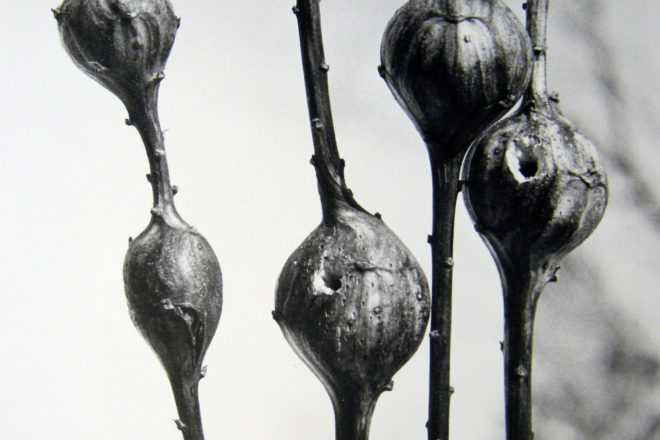Door to Nature: Goldenrod Galls
- Share
- Tweet
- Pin
- Share

The conspicuous remains of many plants poking their heads above the late winter snow are a pleasant reminder of their forthcoming descendants and much-awaited green of spring. Diverse forms of dozens of plants are readily identifiable, some even when viewed from a moving vehicle.
Every time we drive south of Sturgeon Bay on the main highway during the cold season we admire the fragile-looking fluffy masses of fruits on the Virgin’s Bower plants, also called climbing wild clematis, (Clematis virginiana) clinging to shrubs and small trees growing in damp areas.
One of our favorite plants that grow in the rich soil of wet shrubby ditches or along streams is the prickly or wild cucumber. This decorative but inedible high-climbing annual, relative to squashes, is sometimes referred to as the wild balsam-apple. Its prickly oval pods are very unique.
Millions of Queen Anne’s lace and cow parsnip plants hold their many-rayed, somewhat flat-topped umbels well above the foot of snow. Soon the fallow fields and roadsides in all directions will be decorated with their intricate forms and beauty.
Years ago, during a cross-country ski trip at Newport State Park, we were quite interested to see the stiff dark brown fertile fronds of ostrich fern and sensitive ferns protruding above the snow. Their presence that cold day was a gentle reminder that, come June, the snow will be replaced by multitudes of mosquitoes in this secluded and pristine glen.
Silvery-lined milkweed pods, their flat seeds already parachuted to distant places, bring to mind the monarch butterflies that usually arrive by early June in search of young tender milkweed plants so vital in their life cycle. Hatched monarch caterpillars ravenously eat the leaves of only the milkweed plants.
An excellent book to help you identify the remains of last year’s herbaceous plants was written by Jane Embertson of Wauwatosa, Wis. The book, Pods: Wildflowers and Weeds in Their Final Beauty, was published in 1979 by Scribner’s. It might be out of print by now but a search in used book websites may help you find it. Outstanding photographs show exquisite forms of the plants as found in nature as well as these same plant remains used in dried arrangements.
Using plant remains at this season generally produces little risk to the survival of the species. Frequently seed dispersal has been completed by now. Just to be on the safe side check the current regulations protecting certain species and avoid collecting in state parks, preserves and sanctuaries.
One of the most distinctive and tenacious plant forms gracing the outdoor scene throughout the year is the ball-shaped gall on so many goldenrod stems. These spherical formations were instigated by tiny attractive black-mottled-winged flies belonging to the genus Eurosta. Being about the size of houseflies, but related to fruit flies, these creatures mate during the summer.
Plant tissue of a goldenrod stem is pierced by the female’s ovipositor and an egg is deposited into the wound. Healing soon covers the small opening thereby sealing the egg inside the expanding tissue. The injury to the stem alters the plant’s chemistry at that point resulting in a globular enlargement that is referred to as a goldenrod ball gall.
The egg hatches and the larva lives within this tiny chamber lined with a layer of juicy thin-walled cells, the pith of the gall. As the cells are eaten they are quickly replaced for as long as the tiny quarter-inch long cream-colored larva inside requires food. The outer hardened cells of the gall serve as protection for the creature.
A truly amazing thing happens before the larva changes into its pupal or cocoon form. It consumes the plant tissue toward the outer wall and, in so doing, produces an escape tunnel right up to the paper-thin outer shell. This tunnel does not close in. Having done that the larva squirms back to the central chamber where it undergoes the next stage in its metamorphosis, the cocoon.
Without the escape tunnel the goldenrod fly, having emerged during early summer, would have no way of gaining its freedom. Lacking chewing mouthparts it would be imprisoned. Properly prepared it now crawls through the escape hatch, perhaps dissolves the thin outer plant tissue with body fluids, and flies away. Tiny, very neat round holes in the old galls this summer, from last year’s plants, will indicate that the occupants have left. What a miraculous life cycle!
The gall I dissected this morning, about one and a quarter inch in diameter, was quite typical of the hundreds I found in one of thousands of similar patches in this area. I carefully cut the gall vertically in half to find that the larva had eaten its way to the very outer layer. The exit tunnel was at about a 4 o’clock angle from the central chamber.
Many of the fascinating mahogany-colored ball galls I inspected in the field had been visited by downy woodpeckers. A small excavation, always on the side of the gall, revealed the dark opened interior. The one I cut apart showed the insect’s escape hatch to be at a right angle to the downy’s food-finding channel. The gall was empty; the larva having been “fished” out by the woodpecker’s long barbed tongue.
Charlotte asked me, as we ate lunch one day, if I knew that one of the goldenrod ball galls in the dried bouquet on the table was named Charles – Charles de gall! The only answer I could groan in reply was, yes, and have you heard that the little Eurosta flies that inflict so much damage to the goldenrod plants have a lot of gall?



